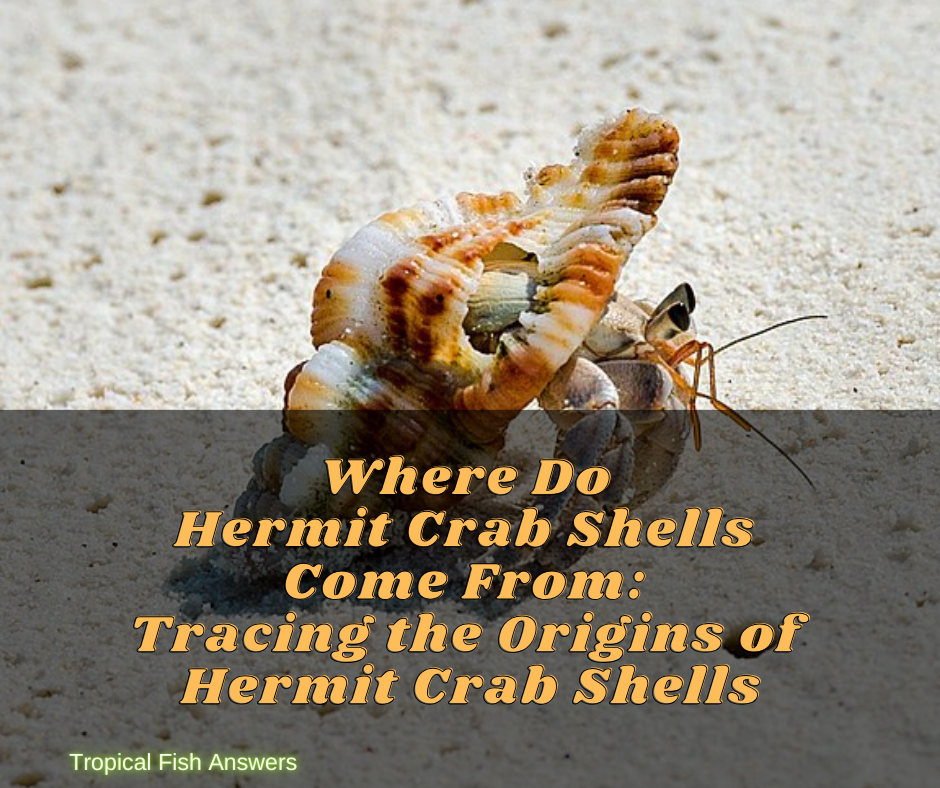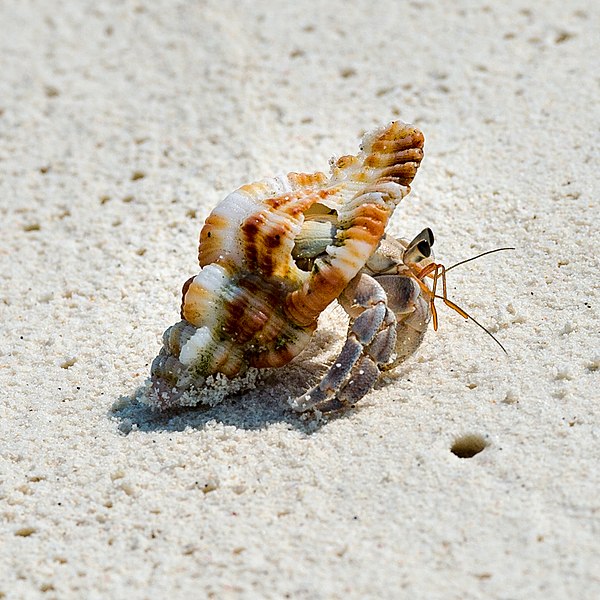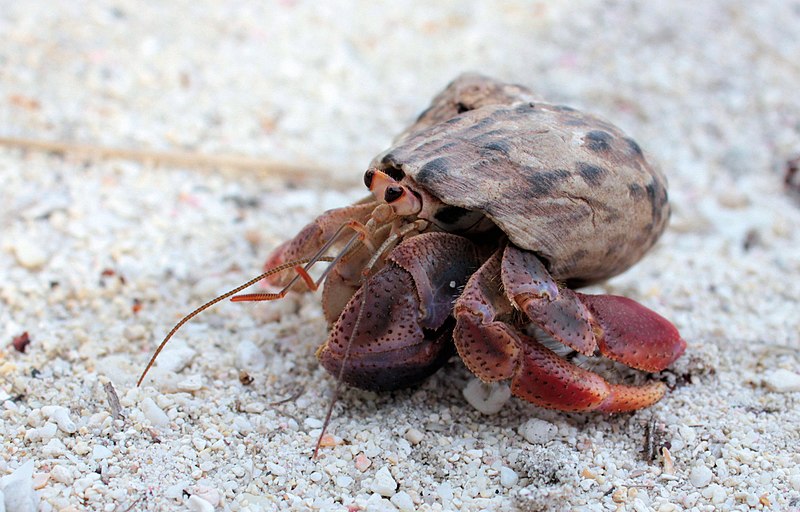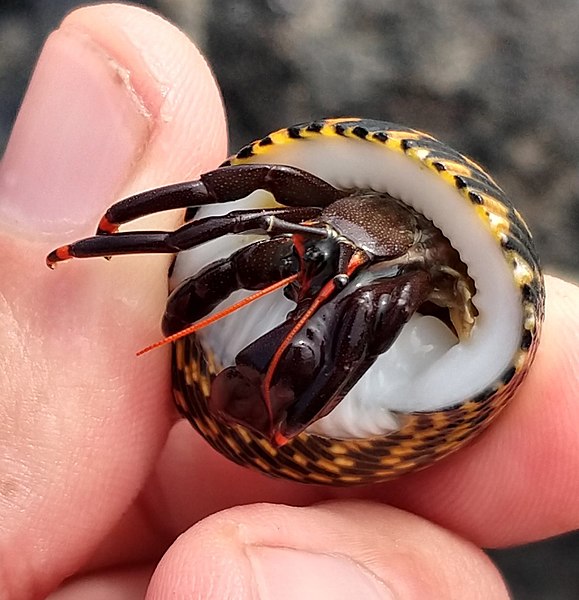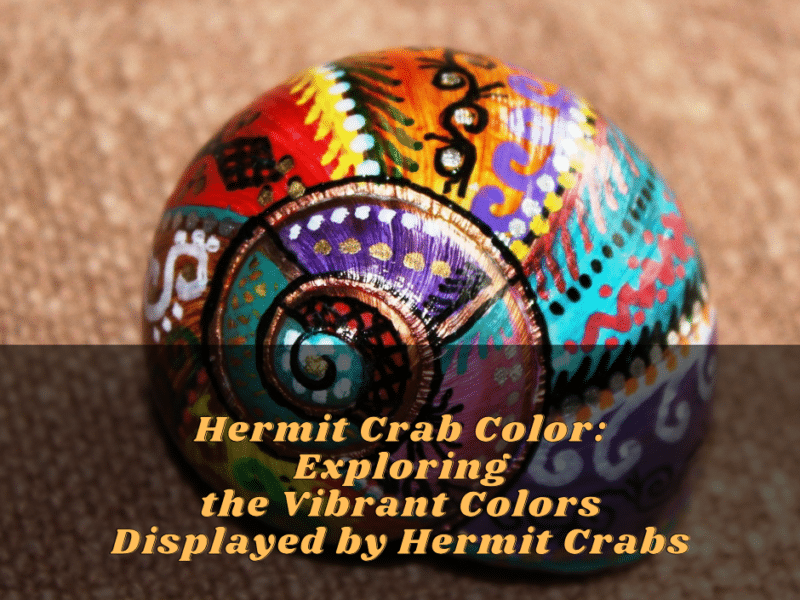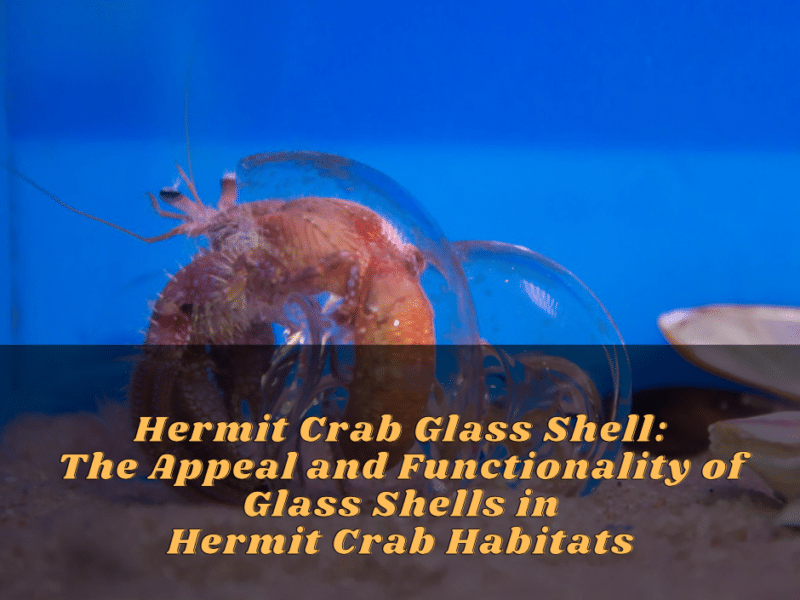Introduction
Hermit crabs are intriguing creatures known for their unique behavior of utilizing empty shells as their homes. These shells provide them protection from predators and serve as a shelter to live in. However, have you ever wondered where these shells come from? In this article, we will delve into the fascinating world of hermit crab shells and explore the origins behind them.
The Fascinating World Of Hermit Crab Shells
Hermit crab shells play a fundamental role in the lives of these crustaceans. As hermit crabs grow, they outgrow their current shells and need to find a larger one to accommodate their increasing size. It is during this process of finding a new home that the captivating world of hermit crab shells is revealed.
Hermit crab shells are not naturally created by the crabs themselves. Instead, they are often discarded shells of other marine creatures, such as snails or mollusks. These empty shells provide the perfect refuge for hermit crabs, who seek shelter inside them.
Understanding The Importance Of Hermit Crab Shells
The significance of hermit crab shells goes beyond just providing protection and a place to live. These shells play a vital role in the survival and well-being of hermit crabs. Here are a few reasons why hermit crab shells are essential:
- Protection: Hermit crab shells serve as a protective armor for these creatures. They provide a hard exterior that shields the soft and vulnerable parts of the crab’s body from potential threats, such as predators or rough surfaces.
- Growth and Development: As hermit crabs grow, they need to upgrade to larger shells to accommodate their increasing size. Without access to suitable shells, hermit crabs may experience restricted growth and face challenges in their development.
- Camouflage and Adaptation: Hermit crabs have evolved to be excellent at blending into their surroundings. They carefully select shells that match their environment, allowing them to camouflage and remain inconspicuous. This ability to adapt their appearance using shells is crucial for their survival.
- Improved Mobility: Hermit crab shells are not only a place to live but also play a vital role in mobility. The shape and design of the shells allow hermit crabs to move efficiently and navigate their surroundings, enabling them to search for food and explore their habitat.
In conclusion, hermit crab shells are not just ordinary shells but serve as the homes and protectors of these fascinating creatures. They provide a safe haven, aid in growth and development, offer camouflage, and improve mobility. Understanding the importance and origins of hermit crab shells gives us a deeper appreciation for the remarkable world of these small crustaceans. So, the next time you come across a hermit crab, take a moment to marvel at the unique shell that guards and shelters its remarkable inhabitant.
Natural Sources Of Hermit Crab Shells
Gastropods: The Original Home Of Hermit Crab Shells
Hermit crab shells have a fascinating origin. These shells are primarily sourced from gastropods, a class of mollusks that includes snails and other shell-bearing creatures. When a gastropod outgrows its shell, it discards it, leaving an empty, vacant home behind. This empty shell becomes a potential refuge for hermit crabs seeking protection and shelter. The unique shape and structure of gastropod shells make them an ideal choice for hermit crab homes.
Marine Environment: Abundance Of Potential Shells
The marine environment is a treasure trove of potential hermit crab shells. Apart from gastropods, other marine creatures such as mollusks also contribute to the availability of shells. This abundance can be attributed to the constant growth and shell renewal processes of these marine organisms. As they grow, they shed their old shells and replace them with new ones. These discarded shells open up opportunities for hermit crabs to find suitable homes.
In addition to natural sources, human activities like shell collecting and shellfish consumption contribute to the availability of shells for hermit crabs. Shells that are discarded or washed ashore become potential options for these resourceful creatures.
Hermit crabs are known for their amazing ability to select the right shell for their size and needs. They carefully evaluate available shells, considering factors such as size, shape, weight, and compatibility with their body structure. Each hermit crab requires a shell that provides a perfect fit, enabling them to retreat inside and protect themselves from predators.
It is important to note that hermit crabs cannot produce their own shells. Instead, they rely on the shells provided by nature for their survival. Without access to suitable shells, hermit crabs face significant challenges, including stunted growth and vulnerability to predators.
Understanding the origins of hermit crab shells offers a deeper appreciation for these incredible creatures. The natural sources of shells, particularly from gastropods and other marine organisms, provide hermit crabs with a diverse range of options for finding their perfect home. The abundance of shells in the marine environment ensures that these resourceful creatures have the opportunity to thrive and adapt to their surroundings.
Next time you come across a hermit crab, take a moment to admire the shell it calls home. The shell not only protects the crab but also represents a fascinating journey of adaptation and survival in the ever-changing marine world.
Factors Influencing Hermit Crab Shell Selection
Shape, Size, And Weight: The Perfect Fit
Finding the right shell is crucial for hermit crabs as it offers them protection and acts as their shelter. When it comes to shell selection, three main factors come into play: shape, size, and weight.
The shape of the shell is an important consideration for hermit crabs. They prefer shells that have a smooth and rounded opening to ensure easy entry and exit. The shape also affects their balance while moving around, so they look for shells that allow them to navigate without difficulties.
Size is another crucial factor. Hermit crabs need shells that fit their bodies perfectly. They carefully evaluate shells, trying them on and testing if they provide enough room for growth. If a shell is too small, the crab will not be able to fully retract into it, making it more vulnerable to predators. On the other hand, if a shell is too big, it can hinder the crab’s movement and make it unable to carry it comfortably.
Weight is also considered during shell selection. Hermit crabs prefer lighter shells as they make it easier for them to move around. Heavy shells can be burdensome and restrict their mobility, making them less agile and more exposed to danger.
Shell Quality: A Matter Of Survival
The quality of the shell is of utmost importance for hermit crabs. They rely on the strength and integrity of the shell to protect themselves from predators and harsh environmental conditions. When assessing a shell’s quality, hermit crabs consider factors such as thickness, durability, and intactness.
A thicker shell provides better protection against potential threats. It acts as a shield, making it harder for predators to break through and reach the vulnerable crab inside. Additionally, a durable shell ensures longevity and reduces the risk of damage from abrasion or the elements.
Hermit crabs also prefer shells that are intact without any cracks or holes. A damaged shell can jeopardize their safety by exposing them to predators or environmental hazards. By selecting shells in good condition, hermit crabs ensure they have a secure and reliable home.
Hermit crabs are resourceful creatures that rely on their ability to find suitable shells for survival. Their meticulous evaluation of shape, size, weight, and shell quality ensures they have the perfect fit and protection they need in their ever-changing marine environment.
By appreciating the factors influencing hermit crab shell selection, we gain a deeper understanding of the incredible adaptation and survival skills possessed by these fascinating creatures. The origins of hermit crab shells trace back to gastropods, marine organisms, and human activities. The abundance of natural sources and the careful selection process of hermit crabs contribute to their ability to thrive and adapt in their unique habitats.
Where Do Hermit Crab Shells Come From? Shell Acquisition Techniques And Challenges
Shell Rappling And Olfactory Signals: Communicating Shell Quality
Hermit crabs have developed unique techniques to acquire suitable shells. One such technique is shell rappling, where crabs form a chain using their pincers and legs to pass shells along until each crab finds the perfect fit. This behavior allows them to explore a wide range of shells and select the one that meets their needs.
In addition to physical evaluation, hermit crabs also rely on olfactory signals to assess shell quality. They release chemical signals that can communicate information about shell availability and suitability. These chemical signals enable crabs to make informed choices about which shells to investigate further and which ones to disregard.
Intraspecies Aggression: Competing For The Best Shells
Hermit crabs face intense competition when it comes to acquiring desirable shells. They engage in intraspecies aggression, where larger crabs often try to forcibly evict smaller crabs from their shells to claim them for themselves. This aggressive behavior highlights the importance of finding a suitable shell for survival and reproductive success.
Competing for the best shells is not without its challenges. Limited availability of suitable shells in the environment poses a significant obstacle for hermit crabs. As shells are a finite resource, increased competition among crabs can lead to conflicts and even alter their behavior.
Furthermore, human activities such as shell collecting for souvenirs or aquarium trade contribute to the scarcity of suitable shells in some areas. This scarcity forces hermit crabs to make do with shells that may not be the optimal fit, increasing their vulnerability to predation and stressful conditions.
Understanding the challenges hermit crabs face in acquiring suitable shells provides insight into their remarkable adaptability. Despite limitations, these resourceful creatures are capable of finding alternative solutions and adjusting their behaviors to meet their needs.
In conclusion, hermit crabs employ unique techniques such as shell rappling and olfactory signals to acquire the perfect shell. However, they also face challenges due to limited availability and competition from other crabs. Environmental factors and human activities further impact the availability of suitable shells. Recognizing the intricacies of shell acquisition sheds light on the incredible adaptation and survival skills exhibited by these fascinating marine creatures.
Shell Recycling And Reuse
Constant Shell Upgrades: A Changing Defense
Hermit crabs are known for their unique shell acquisition techniques, but what happens when they outgrow their shells? Unlike other animals, hermit crabs do not grow their own shells. Instead, they rely on the shells of other marine creatures for protection. As a hermit crab grows, its current shell becomes too small and it must find a new one. This process is called shell upgrading.
When a hermit crab outgrows its shell, it embarks on a search for a larger and more suitable one. This search can be perilous, as the crab is vulnerable to predators without the protection of a shell. The crab must navigate its surroundings and evaluate potential shells based on size, shape, and safety. Once it finds a suitable shell, the hermit crab will abandon its old shell and transfer into the new one.
But what happens to the discarded shells? These shells don’t go to waste. They become available for other hermit crabs to use and recycle. The discarded shells provide a valuable resource for smaller hermit crabs, who eagerly claim them as their new homes. This shell recycling and reuse ensure that shells continue to serve their purpose as protective shelters.
The Circle Of Shells: Reusing Shells In Hermit Crab Communities
Hermit crab communities exemplify the concept of sustainability through shell reuse. As hermit crabs grow and upgrade their shells, the discarded shells are left behind for others to use. These abandoned shells create a circle of shells within the community.
Smaller hermit crabs, unable to compete with larger crabs for shells, are reliant on this circle of shells for their protection. They scavenge and explore the abandoned shells until they find one that fits their size. This reuse of shells allows hermit crab populations to thrive, as it ensures that there is always a supply of suitable shells available.
Interestingly, hermit crabs are known to engage in shell fights, where they try to forcibly take over an occupied shell from another crab. This shell competition further emphasizes the importance of the shell recycling and reuse process within the community.
Not only does shell recycling and reuse provide shelter for smaller hermit crabs, but it also minimizes waste in nature. By utilizing and repurposing shells, hermit crabs demonstrate a sustainable practice that contributes to the balance of the marine ecosystem.
In conclusion, hermit crabs engage in a constant cycle of shell upgrades, ensuring that they always have a suitable and protective shell. The discarded shells become valuable resources for smaller hermit crabs, who reuse them as their new homes. This shell recycling and reuse process exemplifies the concept of sustainability within hermit crab communities, promoting the balance and continuity of their populations and minimizing waste in nature.
Conclusion
Throughout their lives, hermit crabs go through a constant process of upgrading their shells as they grow. When they outgrow their current shells, they search for a larger and more suitable one, leaving their old shell behind. However, these discarded shells do not go to waste. They provide a valuable resource for smaller hermit crabs in need of a new home. This shell recycling and reuse process not only ensures the continued protection of hermit crabs but also promotes sustainability within their communities.
Decoding The Mystery Of Hermit Crab Shells
The origins of hermit crab shells can be traced back to the marine creatures that initially inhabited them. Hermit crabs do not grow their own shells but rely on the availability of empty shells in their environment. The shells they utilize come from a variety of sources, including snails, clams, and other marine gastropods. These shells are typically abandoned by their original occupants, making them available for hermit crabs to repurpose.
The quality and suitability of a shell for a hermit crab are crucial factors in its selection. When a hermit crab searches for a new shell, it evaluates potential options based on size, shape, and safety. The shell needs to be the right fit for the hermit crab’s body and provide adequate protection against predators. Therefore, the availability of suitable shells directly affects the survival and growth of hermit crab populations.
Unveiling The Intricacies Of Hermit Crab Behavior And Survival
Hermit crabs are fascinating creatures that exhibit unique behavior and survival mechanisms. Their dependence on shells for protection creates a constant need to upgrade their living quarters. When a hermit crab outgrows its shell, it becomes vulnerable and must venture out in search of a new and better-fitting one. This process requires the crab to navigate its surroundings, evaluate potential shells, and make a swift switch once a suitable shell is found.
The abandoned shells left behind by hermit crabs become vital resources for smaller crabs who cannot compete with larger individuals for shells. These smaller crabs scavenge and explore the available shells until they find one that fits their size. This practice of reusing shells ensures that there is a continuous supply of suitable living spaces for hermit crabs within their communities.
By engaging in the constant cycle of shell upgrades and recycling, hermit crabs exemplify the concept of sustainability in nature. They repurpose materials, minimize waste, and promote the balance and continuity of their populations. The shell recycling and reuse process also contributes to the overall health and stability of the marine ecosystem.
In conclusion, hermit crab shells originate from a variety of marine creatures and become available for hermit crabs to repurpose when they outgrow their current shells. The selection and acquisition of suitable shells play a vital role in hermit crab survival and growth. Through their behavior of constantly upgrading and reusing shells, hermit crabs demonstrate a sustainable practice that contributes to their own survival and the overall balance of their
FAQ: Where Do Hermit Crab Shells Come From? Tracing the Origins of Hermit Crab Shells
- Can you trace the origins of hermit crab shells?
Yes, hermit crabs can be traced back to the Jurassic period, which occurred between 206 and 144 million years ago. They likely evolved from a lobster-like ancestor, although the exact phylogeny is not fully understood.
- What is the evolutionary history of hermit crabs?
Crabs, in general, have undergone various evolutionary changes. However, these changes were likely imperceptible until after they occurred. Within the diverse order Decapoda, which includes crabs, two main themes of evolutionary change have emerged: Brachyura or true crabs, and Anomura, which includes hermit crabs and others.
- Do hermit crabs create their own shells?
No, hermit crabs cannot excrete their own shells. Instead, adult hermit crabs typically seek out abandoned shells of gastropods (such as snails) to inhabit and protect their asymmetric soft abdominal parts.
- How has the hermit crab’s anatomy adapted to fit different shells?
The hermit crab’s abdomen has evolved to become decalcified, allowing for a range of different shell sizes and shapes. The abdominal musculature has also adapted to support and grasp the shell in its spirals. This muscular system not only provides protection but also acts as a hydrostatic support for each new shell.
- Are there any fossil records of hermit crabs?
While little is known about the fossil record of land hermit crabs, a walking trace fossil attributed to a land hermit crab has been described. This fossil, named “Coenobichnus currani,” was found in an early Holocene eolianite deposit on the island of San Salvador in the Bahamas. The fossil trackway retains the distinctive asymmetry and interior drag trace characteristic of modern land hermit crab walking traces.
- What can we learn from the study of hermit crab shells?
Studying hermit crab shells offers insight into important evolutionary principles, such as bilateral symmetry. Interestingly, hermit crabs have abandoned this concept to some extent. They possess a curved soft abdomen that fits snugly into the empty shells they inhabit, and this asymmetry even extends to their neuromuscular system. However, it’s worth noting that the first-stage free-swimming larvae, known as zoea, are symmetrical before developing their characteristic asymmetry.
Please note that the information provided in these FAQs is based on online data and scientific research available on the subject matter.
